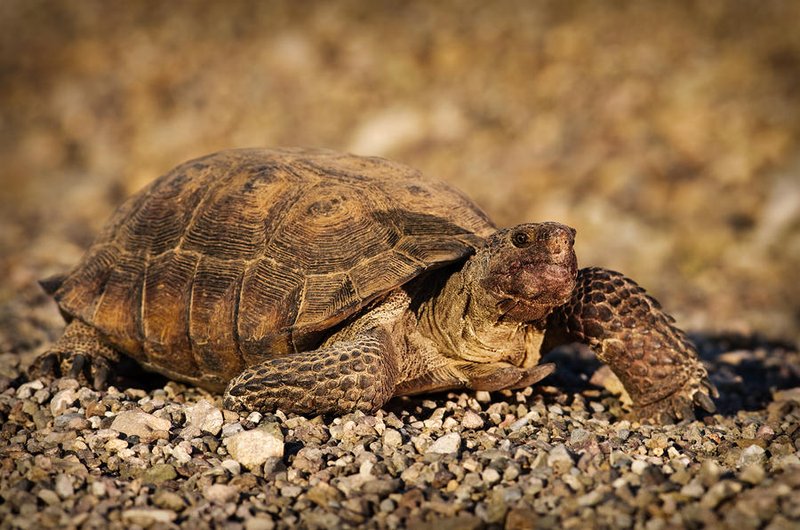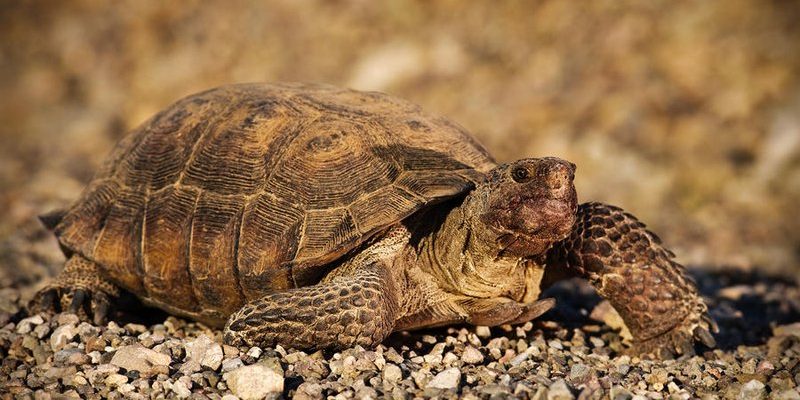
Imagine a creature that can live for over a hundred years, munches on cacti, and calls the dry desert its home. Meet the Desert Tortoise, a resilient reptile that embodies the spirit of survival in one of the harshest environments on Earth. A slow and steady walker, this tortoise navigates the sandy terrain with a fascinating lifestyle that many of us may find astonishing.
Considered a symbol of the American Southwest, the Desert Tortoise is a unique animal that has adapted over millions of years to thrive where few others can. With its impressive ability to store water and withstand drought conditions, it’s no wonder this tortoise has captured the hearts of wildlife enthusiasts and nature lovers alike. So, let’s dig deeper into the life and habits of this incredible tortoise!
Physical Characteristics
The Desert Tortoise is easily recognizable thanks to its sturdy, dome-shaped shell, which can reach lengths of up to 14 inches. This armored exterior serves as both a protective barrier against predators and a natural climate control system. The shell’s coloration, typically a mix of browns and tans, allows the tortoise to blend into the arid landscape, making it harder for potential threats to spot. Additionally, its strong legs are adapted for digging—an essential skill for creating burrows that provide shelter from extreme temperatures.
These tortoises are not just tough on the outside; they have some unique internal adaptations as well. For instance, they can absorb water through their skin and store it in their bodies for long periods, which is vital in a habitat where water isn’t always available. Their bodies are also designed to minimize water loss, which is critical for survival in their dry environment. In many ways, the Desert Tortoise is like a living water bottle—smartly designed to make the most out of what little moisture it can find.
In terms of color and appearance, hatchlings start with a darker shell and gradually lighten as they grow older. This change helps them adapt to their environment as they grow and encounter different conditions. The Desert Tortoise’s distinct features not only make it a fascinating subject for study but also highlight the incredible adaptability of nature.
Habitat and Range
The Desert Tortoise primarily resides in the Mojave and Sonoran Deserts of the southwestern United States, including parts of California, Arizona, Nevada, and Utah. This region is characterized by rocky hills, sandy plains, and an array of plant life, such as creosote bushes and cacti. The tortoise prefers areas with loose soil, as this makes it easier to dig burrows for shelter and nesting.
These burrows serve multiple purposes—providing shade during the scorching daytime heat and protection from colder temperatures at night. On average, a single tortoise might have several burrows within its home range, where it can escape from the sun and find safety during storms. During particularly hot days, they can retreat deep into their burrows, where temperatures remain much cooler compared to the outside heat.
Interestingly, the Desert Tortoise’s habitat also plays a pivotal role in its diet. They mostly eat native plants, especially those rich in water content, like grasses and flowering plants. This diet is not just a source of nutrition; it also helps the tortoise maintain hydration levels, which is crucial for its survival in such an arid environment.
Diet and Feeding Habits
What’s on the menu for a Desert Tortoise? It turns out, they’re herbivores with a taste for a variety of desert plants. They mostly munch on grasses, wildflowers, and the pads of cactus. This diverse diet not only meets their nutritional needs but also helps them stay hydrated in the desert. You might find it surprising that many of the plants they consume can hold a significant amount of moisture, which is essential for their survival.
Desert Tortoises typically feed in the early morning hours or late afternoon when temperatures are cooler. During the heat of the day, you’re unlikely to see them out and about. Instead, they conserve their energy and remain hidden in their burrows. This behavior is essential for their survival, as it reduces the risk of overheating and dehydration.
Another interesting aspect of their feeding is the way they interact with their environment. By eating certain plants, Desert Tortoises play a significant role in their ecosystem. They help with seed dispersal, allowing new plants to grow and thriving in their habitat. So, in a way, they’re not just eating; they’re also helping sustain the environment that supports them.
Reproduction and Lifespan
When it comes to love and reproduction, the Desert Tortoise has a fascinating ritual. Mating usually occurs in the spring, when temperatures begin to rise. Males will engage in head-bobbing displays and even try to flip each other over in a show of dominance. Once paired, the female lays her eggs in the late spring or early summer, often digging a nest in soft soil in her burrow.
After a gestation period of about 60 to 90 days, the hatchlings emerge, usually in the late summer. They are about the size of a quarter and have a tough start to life ahead of them. Only a small percentage of tortoise hatchlings survive to adulthood, as they face numerous predators, including birds, mammals, and even other tortoises!
One of the remarkable traits of the Desert Tortoise is its incredible lifespan, often reaching over 50 years and sometimes even more than 100 years. This longevity is not just a testament to their hardiness, but it also allows them to play a vital role in their ecosystems for extended periods. Knowing that they can be around for so long adds to the mystique of these wonderful creatures.
Conservation Status
Despite their remarkable adaptations, Desert Tortoises are facing significant threats. Their populations have been declining due to habitat destruction, climate change, and the effects of human activity. Urban development, agriculture, and off-road vehicle use have all contributed to the loss of their natural homes. In addition, the illegal pet trade has posed a catastrophic risk to local populations.
To combat these challenges, conservation efforts are being implemented in various regions. Protected areas are set up to preserve their habitats, and educational programs are in place to raise awareness about the importance of these tortoises. Organizations are collaborating to restore damaged habitats and monitor tortoise populations to ensure their survival.
Protecting the Desert Tortoise is not just about saving a single species; it’s about preserving the entire ecosystem that supports a wide variety of plants and animals. By taking steps to conserve their habitat, we can help ensure that future generations can learn about and admire these incredible reptiles.
Interesting Facts
| Scientific Name: | Gopherus agassizii |
| Size: | 12-14 inches long |
| Lifespan: | 50-100 years |
| Diet: | Herbivorous, eats grasses, flowers, and cactus |
| Habitat: | Mojave and Sonoran Deserts |
| Predators: | Ravens, coyotes, and domestic pets |
| Movement Speed: | Up to 0.3 mph |
Behavior and Social Structure
Desert Tortoises are generally solitary creatures, spending most of their lives alone. They are not very territorial, but they do have a home range where they seek food and shelter. You might observe them interacting with other tortoises during mating season or while competing for food, but once the season is over, they retreat back to their individual routines.
These tortoises exhibit a fascinating behavior called “basking.” On sunny days, they can often be seen resting on warm rocks or soil to soak up the sun’s rays. This behavior is crucial for their health, as it helps regulate their body temperature. During this basking time, they may also exhibit social behaviors, like communicating through subtle body movements or vocalizations.
Though they may appear slow and unassuming, Desert Tortoises have an intricate social structure that connects them to their environment. They rely on their keen senses to detect predators and environmental changes. Their ability to adapt to various conditions is impressive and showcases the beauty of the natural world.
FAQ
What do Desert Tortoises eat?
Desert Tortoises primarily feed on a variety of desert plants, including grasses, wildflowers, and cacti. Their diet is crucial for hydration and nutrition. They tend to eat in the early morning or late afternoon when it’s cooler, conserving energy during the hot midday sun.
How long can a Desert Tortoise live?
The lifespan of a Desert Tortoise can range from 50 to over 100 years! Their long life is partly due to their ability to adapt and thrive in a challenging environment, making them one of the more resilient reptiles.
Are Desert Tortoises endangered?
Yes, Desert Tortoises are classified as a threatened species. Their populations have declined due to habitat destruction, climate change, and human activities. Conservation efforts are underway to protect their habitats and educate the public about their importance.
How do Desert Tortoises survive in the desert?
Desert Tortoises have several adaptations that help them survive in the harsh desert climate. They can store water in their bodies, absorb moisture through their skin, and dig burrows to escape extreme temperatures. These adaptations are essential for their survival.
Where can I find Desert Tortoises?
Desert Tortoises are native to the Mojave and Sonoran Deserts of the southwestern United States. They are typically found in areas with loose soil and vegetation, where they can dig burrows and find food.
Do Desert Tortoises have any predators?
Yes, Desert Tortoises face threats from several predators, including ravens, coyotes, and domestic pets. Hatchlings, in particular, are vulnerable to various animals, highlighting the challenges these tortoises face in their environment.
Can Desert Tortoises be kept as pets?
While Desert Tortoises can be kept as pets, it’s essential to understand their care requirements and legal regulations regarding ownership. They need a spacious habitat, proper diet, and a lot of care to thrive as pets. Moreover, it’s often discouraged to take them from their natural habitats due to conservation concerns.
What role do Desert Tortoises play in their ecosystem?
Desert Tortoises play a vital role in their ecosystem by helping with seed dispersal and maintaining plant populations. By consuming various plants, they contribute to the overall health of their environment, supporting a broad range of wildlife.
How can I help Desert Tortoises?
You can help Desert Tortoises by supporting conservation programs, spreading awareness about their needs, and participating in local habitat restoration efforts. Additionally, avoid driving off-road in desert areas to protect their habitats.
Are there any unique behaviors of Desert Tortoises?
Desert Tortoises exhibit unique behaviors, including basking in the sun to regulate their body temperature and digging complex burrows for shelter. They communicate with each other through body language and subtle vocalizations, showcasing their social interactions.
How do Desert Tortoises reproduce?
Desert Tortoises mate in the spring, with females laying eggs in late spring or early summer. They dig nests in soft soil, and after a gestation period of 60 to 90 days, hatchlings emerge, marking the continuation of their life cycle.
What happens to Desert Tortoises during extreme weather?
During extreme heat, Desert Tortoises retreat to their burrows to avoid overheating. In colder months, they can enter a state of brumation (similar to hibernation) to conserve energy and survive until warmer weather returns.
Where can I learn more about Desert Tortoises?
To learn more about Desert Tortoises, consider visiting wildlife reserves, national parks, or educational websites dedicated to reptiles. Local conservation groups often provide valuable resources and insights about these incredible creatures.

